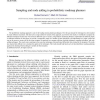Free Online Productivity Tools
i2Speak
i2Symbol
i2OCR
iTex2Img
iWeb2Print
iWeb2Shot
i2Type
iPdf2Split
iPdf2Merge
i2Bopomofo
i2Arabic
i2Style
i2Image
i2PDF
iLatex2Rtf
Sci2ools
RAS
2006
2006
Sampling and node adding in probabilistic roadmap planners
The probabilistic roadmap approach is one of the leading motion planning techniques. Over the past decade the technique has been studied by many different researchers. This has led to a large number of variants of the approach, each with its own merits. It is difficult to compare the different techniques because they were tested on different types of scenes, using different underlying libraries, implemented by different people on different machines. In this paper we provide a comparative study of a number of these techniques, all implemented in a single system and run on the same test scenes and on the same computer. In particular we compare collision checking techniques, sampling techniques, and node adding techniques. The results were surprising in the sense that techniques often performed differently than claimed by the designers. The study also showed how difficult it is to evaluate the quality of the techniques. The results should help future users of the probabilistic roadmap pl...
Related Content
| Added | 14 Dec 2010 |
| Updated | 14 Dec 2010 |
| Type | Journal |
| Year | 2006 |
| Where | RAS |
| Authors | Roland Geraerts, Mark H. Overmars |
Comments (0)

